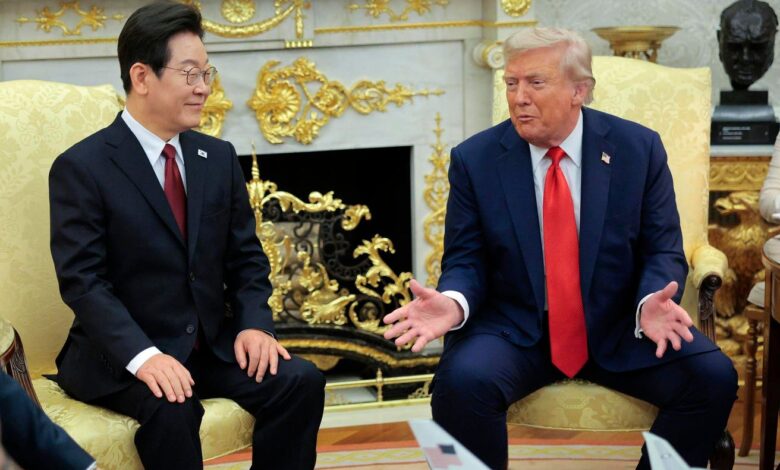Korea Avoided ‘Zelensky Moment’ With Trump. Now Comes The Hard Part

📝 usncan Note: Korea Avoided ‘Zelensky Moment’ With Trump. Now Comes The Hard Part
Disclaimer: This content has been prepared based on currently trending topics to increase your awareness.
WASHINGTON, DC – AUGUST 25: U.S. President Donald Trump (R) meets with President of South Korea Lee Jae Myung in the Oval Office at the White House on August 25, 2025 in Washington, DC.
Chip Somodevilla/Getty Images
Call it the bigotry of low geological expectations.
When South Korean President Lee Jae Myung had his moment in the Oval Office hot seat on Monday, his staff worried he might get the Volodymyr Zelensky treatment. Hours before Lee arrived at the White House, President Donald Trump took to social media with what Lee described as “a very threatening post” about this year’s political volatility in Seoul, which saw Lee’s predecessor impeached and removed from office.
Luckily for Team Lee, Trump avoided berating him for the cameras, the way he did Ukrainian President Zelensky earlier this year. Lee said the exchange was “beyond my expectations.”
Fair enough. But Lee’s newish administration would be remiss to think that he and Trump came away pals — that they struck up some sort of U.S.-Korea bromance.
It’s a nice fantasy, admittedly. However, an earlier adoring kinship between Trump’s America and Japan should give Lee cause for concern.
The reference here is to former Japanese Prime Minister Shinzo Abe, who was Trump’s main bromantic partner during his first presidency from 2017 to 2021. More than any world leader, Abe perfected the art of winning Trump’s favor with flattery, lavish gifts, sitting with him in the Group of Seven lunchroom when others wouldn’t and nominating him for a Nobel Peace Prize.
Japan got zero for it. Abe’s obsequiousness didn’t score Tokyo a waiver on Trump’s steel and aluminum tariffs. Trump still pulled out of the Trans-Pacific Partnership, the cornerstone of Japan’s efforts to rein in China. Abe had much explaining to do to Liberal Democratic Party elders as Trump palled around with North Korean tyrant Kim Jong Un at the expense of Japan’s national security interests.
Unfortunately, the late Abe also set the standard for fawning Trump attentiveness. Trump 2.0 has world leaders everywhere nominating Trump for a Nobel in a ploy to curry favor. In June, when NATO Secretary General Mark Rutte called Trump “daddy,” he was reading from the Abe playbook.
Not surprisingly, Lee left the White House empty-handed. His attempted charm offensive didn’t convince Trump to alter the terms of the 15% U.S.-Korea tariff deal, which includes hundreds of billions of dollars of investment in the U.S.
“We stuck to our guns,” Trump told reporters after the meeting. “They’re going to make the deal that they agreed to make.”
It’s a reminder that, despite smiles and warm moments between Lee and Trump, Asia’s fourth-biggest economy is essentially on its own when it comes to the U.S. Trump’s tariff pacts are more shakedowns than negotiations. And, let’s face it, Trump feels a greater connection with dictator Kim up North than the South’s democratic government.
Yet it’s a reminder, too, that time isn’t on South Korea’s side when it comes to safeguarding the economy from Trump’s trade war.
The problem for Korea is the pre-existing conditions it carried into 2025, before Trump began imposing tariffs on economic friends and foes alike.
Lee took office in June, replacing Yoon Suk Yeol, after Yoon’s removal from office for declaring martial law last December. Yet Yoon’s 2022-2025 presidency was the fifth in 20 years of overpromising major reforms to increase competitiveness and innovation and underdelivering.
Yoon and predecessors Moon Jae-in (2017-2022), Park Geun-hye (2013-2017), Lee Myung-bak (2008-2013), and Roh Moo-hyun (2003-2008) all to varying degrees pledged to level playing fields and reduce the role of exports as the leading growth engine. Each set out to curb the economic dominance of family-owned conglomerates, increase efficiency and boost average wages.
Each, though, repeated a now well-established pattern: getting growth into the 2%-3% range, declaring victory and then pivoting to other pursuits. This cycle prevents bold moves to disrupt an economic system that’s putting Korea at a disadvantage in the Chinese era.
For all its challenges, China continues to upend the global pecking order. Its ginormous investments in higher-value, tech-heavy sectors from smartphones to autos to semiconductors to biotechnology are disrupting the global landscape at bewildering speed.
In export-driven, top-down Korea, maintaining global market share requires constant recalibration. Unfortunately, six months of disorientation caused by Yoon’s disastrous martial law decree — which Trump wrote “seems like a Purge or Revolution. We can’t have that and do business there” — set back structural reforms efforts at the very worst moment.
One big, and largely unaddressed, problem is reining in the handful of family-owned conglomerates, or chaebols, that tower over the economy. Since the 1997 Asian crisis, a succession of governments set out to create more economic space for small-and-medium-sized companies to thrive.
Once they realized the magnitude of the task, each leader, like clockwork, pivoted to working with the chaebols, not wrestling economic power away from them. It’s early days for Lee, who took office just 84 days ago. But he must hit the ground running to change the mechanics of the economy as fallout from Trump’s tariffs puts Korea in harm’s way.



